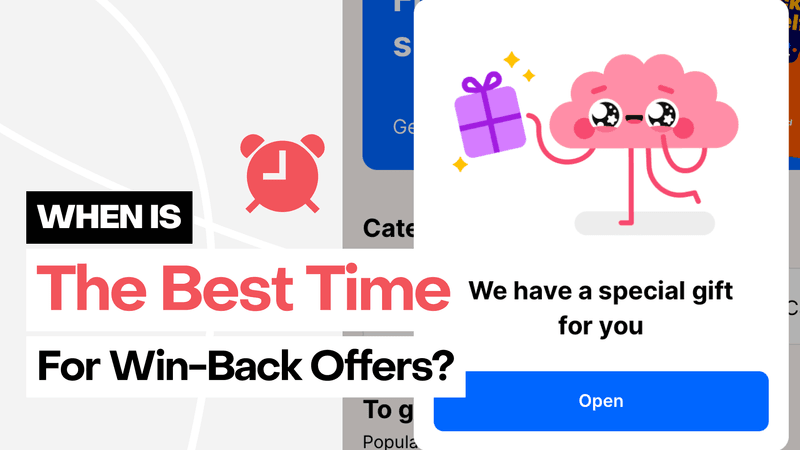As Eric Seufert writes in the monetization trap, “Retention is the primary driver of value for any consumer product”. One powerful tool in your retention arsenal is the win-back campaign. But to maximize its effectiveness, timing is everything.
So, when is the best time to send a win-back offer? In most cases, there is a simple answer to this question: as soon as possible. The longer you wait before you attempt to retain a user, the less relevant your app has become to them. But what should your triggers be?
In this blog, we’ll explore key moments in the user journey when a well-timed offer can make all the difference. And if you’re looking for something that’s going to move the needle immediately, begin with the first moment in this list.
Key takeaways:
- Onboarding phase: Send a win-back offer if a user exits during onboarding without completing the desired action.
- After trial cancellation: Immediately offer a personalized message or discount to users who cancel their trial.
- Before subscription renewal: Encourage continued engagement with a loyalty discount or exclusive features just before renewal.
- After inactivity: Identify periods of inactivity and send offers to re-engage users before they fully disengage.
- Seasonal or event-driven moments: Align win-back campaigns with relevant seasons or events to leverage heightened interest.
- New features: Re-engage users by highlighting significant updates or new features, paired with an exclusive offer.
- Post-feedback: Follow up on user feedback with a targeted win-back offer that addresses their concerns.
1. During the onboarding phase
The onboarding phase is your first — and sometimes only — chance to make a lasting impression. Users who download your app are most engaged and curious during this initial interaction. However, many users may drop off during onboarding if they don’t immediately see the value in your app.
Best practice: If a user exits the app during onboarding without completing the desired action (e.g., signing up for a trial or subscription), this is a prime opportunity to offer a win-back incentive. A discount or a free trial extension can entice users to give your app another try before they completely disengage.


2. Immediately after a trial cancellation
One of the most crucial points in the user journey is the end of a free trial. Users who cancel their trial are signaling a potential loss of interest. However, this doesn’t mean they’re gone for good.
Best practice: Sending a win-back offer immediately after a user cancels a trial can recapture their attention. A personalized message, combined with a limited-time discount or additional free trial period, can effectively persuade them to reconsider and continue using your app.
3. Before subscription renewal (for high-risk users)
For subscription apps, the period leading up to a subscription renewal is crucial, especially for users on yearly plans or those who have shown signs of disengagement. While users who haven’t turned off auto-renew may not need an incentive, those who are on the fence or have displayed decreased activity might benefit from a targeted win-back offer.
Best Practice: If you identify users who are at risk of canceling before their renewal — perhaps due to inactivity or other indicators — consider offering a loyalty discount. For example, as Hannah Parvaz shares in “how to win back lost customers“, focus your efforts just before users typically change their billing status. At one of her companies, they discovered that annual subscribers were most likely to change their billing status around day 290, so they targeted their win-back efforts starting on day 280. This proactive approach can help retain users who might otherwise churn, ensuring they see continued value in maintaining their subscription.
4. After a significant inactivity period
Sometimes users disengage without explicitly canceling a trial or subscription. They may still have your app installed, but they haven’t opened it in weeks or months. These dormant users represent a key opportunity for re-engagement.
Best Practice: Analyze user activity to identify when a user typically disengages. For example, if most users tend to drop off after 30 days of inactivity, consider sending a win-back offer at the 21-day mark. The offer could be a special discount, a reminder of the app’s value, or an announcement of new features that might draw them back in.

5. Seasonal or event-driven moments
Depending on your app’s category, certain times of the year may be more effective for sending win-back offers. For example, fitness apps might see higher re-engagement rates in January when people are setting New Year’s resolutions.
Best Practice: Tailor your win-back campaigns to align with relevant seasons, events, or milestones. Offering a limited-time promotion during these periods can create a sense of urgency and capitalize on your users’ seasonal needs or interests.
6. When introducing major updates or new features
Launching significant updates or new features can serve as a powerful re-engagement tool. Users who previously disengaged might be interested in returning if they see that your app has evolved or now offers something new.
Best Practice: Notify inactive users of major updates with a win-back offer tied to the new features. Highlight how the update improves their experience, and sweeten the deal with an exclusive discount or a free trial of the new features.

7. After receiving feedback or conducting surveys
If you’ve conducted a user survey or received feedback from users who decided not to continue with your app, this is an excellent time to send a win-back offer. These users have already engaged with you on some level, making them more likely to respond to a targeted offer.
Best Practice: Follow up on the feedback with a personalized win-back message. Acknowledge their concerns or reasons for leaving, and offer them a special incentive to return, emphasizing how your app addresses their feedback.
Final thoughts: Timing is everything
The key to a successful win-back campaign lies in understanding your users’ behavior and strategically timing your offers to align with their needs. By identifying the right moments in the user journey — whether during onboarding, after a trial cancellation, or during periods of inactivity — you can significantly increase the chances of re-engaging users and reducing churn. Just remember that those right moments might differ app-by-app. However, if you apply and test the examples in this blog, you’ve got a fantastic starting point.

